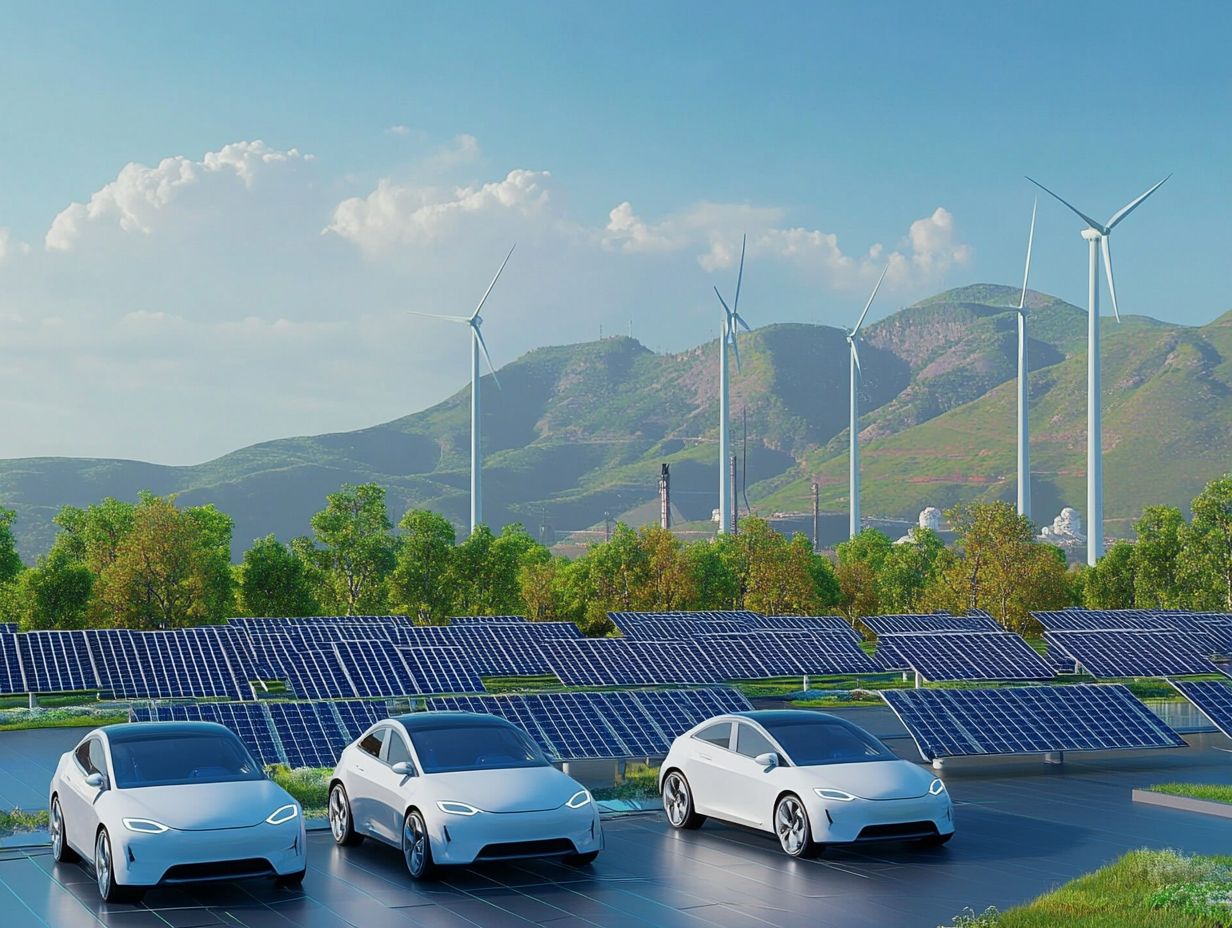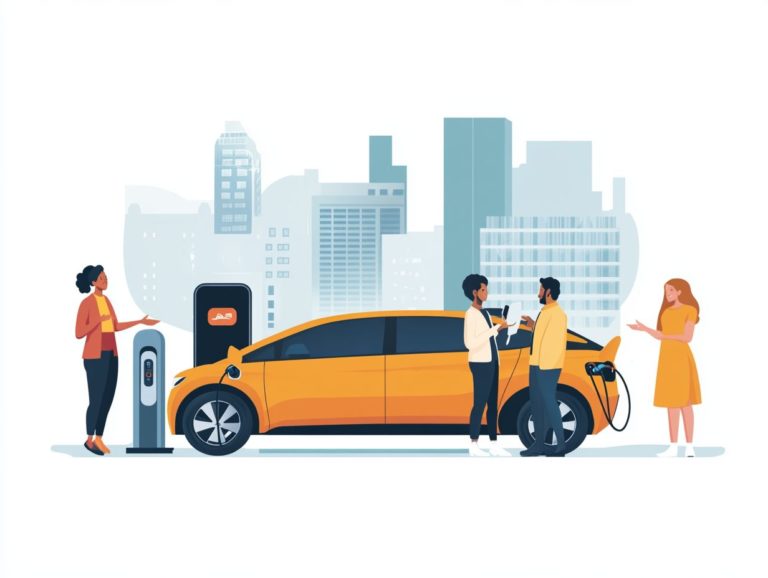The Intersection of EVs and Renewable Energy
Electric vehicles (EVs) and renewable energy sources are transforming your perspective on transportation and sustainability.
Their integration heralds a future marked by cleanliness, significantly diminishing carbon footprints and reducing energy costs. However, challenges such as infrastructure demands and regulatory hurdles linger on the horizon.
This article delves into the advantages of merging EVs with renewables, the obstacles that lie ahead, and the initiatives currently in motion.
Envision a greener tomorrow with us, fueled by innovation and a steadfast commitment to environmental stewardship.
Contents
- Key Takeaways:
- The Benefits of Combining EVs and Renewable Energy
- The Challenges of Integrating EVs and Renewable Energy
- Current Initiatives and Solutions
- The Future of EVs and Renewable Energy
- Frequently Asked Questions
- What is the intersection of EVs and renewable energy?
- How EVs and Renewable Energy Team Up for a Greener Future!
- What are the benefits of the intersection of EVs and renewable energy?
- How does renewable energy impact the production of EVs?
- What challenges does the intersection of EVs and renewable energy face?
- How can individuals contribute to the intersection of EVs and renewable energy?
Key Takeaways:

- Combining EVs and renewable energy can significantly reduce carbon footprints and lower energy costs.
- Infrastructure, grid management, and policy and regulation are key challenges in integrating EVs and renewable energy.
- Government incentives and technological advancements are driving initiatives to promote the future growth and impact of EVs and renewable energy.
What are EVs and Renewable Energy?
Electric Vehicles (EVs) mark a significant transformation in the transportation sector, seamlessly blending innovation with sustainability. By harnessing renewable energy sources for operation, these vehicles, including battery electric vehicles (BEVs) and plug-in hybrid electric vehicles (PHEVs), employ cutting-edge technologies like electric motors and solar photovoltaic systems.
This approach reduces reliance on fossil fuels and curtails greenhouse gas emissions.
As countries pursue energy independence and sustainability objectives, integrating EVs with renewable energy sources such as solar power is becoming crucial in the fight against climate change.
By tapping into the potential of wind, solar, and hydropower, EVs not only enhance energy efficiency but also foster the broad adoption of clean energy practices. Recent breakthroughs in battery technology, especially with solid-state batteries, have dramatically improved energy storage and charging times.
This advancement allows electric vehicles to cover longer distances, making them practical for daily use.
The emergence of smart grid technologies enables efficient energy management and distribution, optimizing the utilization of renewable sources in real-time. Such innovations elevate the overall performance of EVs and contribute to a cleaner, more resilient energy infrastructure, ultimately bolstering global sustainability efforts.
The Benefits of Combining EVs and Renewable Energy
By combining Electric Vehicles (EVs) with renewable energy sources, you unlock a multitude of benefits that align seamlessly with sustainability goals and the relationship between EVs and energy independence initiatives.
This integration also raises energy efficiency and fosters energy independence, playing a crucial role in significantly reducing greenhouse gas emissions. This paves the way for a more sustainable future.
Reducing Carbon Footprint
One of the most compelling advantages of integrating Electric Vehicles (EVs) with renewable energy sources is the remarkable reduction in your carbon footprint. By embracing zero tailpipe emissions and clean energy, you can replace fossil fuel dependency and take a significant step toward lowering greenhouse gas emissions and combating climate change.
This synergy is pivotal in cultivating a greener transportation ecosystem. For instance, a comprehensive study in California found that powering EV charging stations with renewable energy could eliminate up to 80% of carbon emissions linked to conventional vehicles.
In Norway, a trailblazer in electric mobility, over 54% of new car sales in 2020 were EVs, primarily energized by hydroelectric power, highlighting the potential for sustainable travel.
These encouraging statistics emphasize the profound impact of leveraging renewable resources to transition towards more sustainable and eco-friendly transportation solutions. Join the movement towards clean transportation today!
Lowering Energy Costs
Lowering energy costs is one of the standout benefits of embracing Electric Vehicles (EVs) powered by renewable energy sources, especially solar power. By integrating EV charging with solar energy, you help you rely less on others for energy and enjoy long-term cost savings for yourself or your business.
When you harness the sun’s energy, you will drastically reduce your dependence on traditional utility companies, resulting in lower monthly electricity bills. As more individuals opt for solar-powered charging stations, they effectively reduce their reliance on fossil fuels, making a positive impact on the environment.
Government incentives like tax credits and rebates make the initial investment in solar technology much more attainable. These economic advantages not only enhance your return on investment but also encourage a shift toward sustainable practices, paving the way for a greener future while bolstering local economies.
The Challenges of Integrating EVs and Renewable Energy

While the benefits of integrating Electric Vehicles (EVs) with renewable energy sources are indeed promising, there are notable challenges to consider, especially regarding charging infrastructure and grid integration.
Effectively managing energy demand while ensuring efficient EV charging calls for careful planning and the adoption of advanced smart grid technologies.
Infrastructure and Grid Management
A strong charging infrastructure is vital for successfully integrating Electric Vehicles (EVs) with renewable energy. This requires advancements in smart grid technology and effective ways to store energy.
With proper grid integration, you can ensure EV electricity demand does not disrupt your energy supply. Strategically located charging stations offer you convenient energy access while you re on the move.
Energy storage systems capture extra energy from renewable sources. This ensures a reliable power supply during peak demand times.
Smart grids manage energy flow efficiently. They adapt to real-time changes in supply and demand, ensuring that charging stations allocate resources when you need them the most. This creates a sustainable environment that supports the widespread adoption of EVs.
Policy and Regulation
Policy and regulation play a pivotal role in your journey toward adopting Electric Vehicles (EVs) powered by renewable energy. Government incentives serve as a catalyst, propelling you toward greater energy independence. With effective policies in place, you can benefit from electric vehicle purchase incentives while also supporting renewable energy initiatives.
These frameworks drive innovation and change in the market, encouraging manufacturers to develop more efficient technologies tailored to your needs. For example, tax credits, rebates, and subsidies not only make EVs more accessible for you but also spark investments in charging infrastructure, enhancing usability and convenience.
As local and federal governments enforce stricter emissions regulations, they create a compelling case for you to transition to electric transportation. These measures can influence your choices, nudging you toward adopting cleaner alternatives. Supportive policies and your readiness can significantly accelerate the shift to a sustainable energy future.
Current Initiatives and Solutions
Exciting new initiatives are transforming how we think about Electric Vehicles (EVs) and renewable energy! Current initiatives and solutions focus on government incentives and technological advancements that pave the way for a cleaner transportation sector.
These endeavors encompass the installation of solar charging stations and improvements in battery technology aimed at enhancing performance and efficiency.
Government Incentives and Programs
Government incentives and programs play a crucial role in encouraging the adoption of Electric Vehicles (EVs). They offer purchase incentives and solar energy subsidies that improve energy efficiency, making it easier for you to transition to cleaner transportation options.
For example, many governments provide attractive tax credits that can lower the price of purchasing an EV, making it more accessible for buyers like you. Rebates for installing home solar panels simplify your shift towards renewable energy, enhancing the overall financial appeal.
Case studies from various states highlight this impact. In California, for instance, increased incentives have led to a remarkable rise in EV registrations and renewable energy installations. This evidence underscores the importance of these programs in achieving sustainable energy goals while offering you significant financial benefits.
Technological Advancements

Technological advancements are revolutionizing the world of Electric Vehicles (EVs) and renewable energy, particularly through improvements in battery technology and enhanced smart grid systems that optimize charging efficiency. These innovations are essential for managing energy storage and promoting the use of renewable sources.
As you explore the growing market for electric vehicles, you’ll find that these technologies do more than facilitate faster charging; they enable seamless integration of solar and wind energy into the grid. Breakthroughs like solid-state batteries promise higher energy densities and quicker recharging times, which are sure to catch your interest as an EV user.
Smart grids use real-time data analytics to adjust energy distribution according to demand, ensuring that renewable sources are harnessed to their fullest potential. The collaboration between advanced batteries and smart grid systems lowers charging costs and plays a vital role in advancing environmental sustainability by reducing reliance on fossil fuels.
The Future of EVs and Renewable Energy
The future of Electric Vehicles (EVs) and renewable energy is incredibly exciting and full of potential, driven by technological advancements and rising demand for energy independence in the transportation sector. Understanding why EVs are crucial for a sustainable future is key to this transformation.
This transformation will redefine your perspective on mobility and energy consumption, ushering in a new era of efficiency and sustainability.
Predicted Growth and Impact
The anticipated growth in the Electric Vehicle (EV) market, combined with a significant shift towards renewable energy sources, is set to transform transportation emissions and energy independence. As electric vehicle fleets multiply, your transition to cleaner energy will gain momentum.
Forecasts suggest that by 2030, EV adoption could reach as much as 30% of total vehicle sales in developed countries, leading to a major reduction in harmful emissions. A recent report indicates that widespread EV usage could cut carbon dioxide output by nearly 50 million metric tons annually.
As you choose electric models, the demand for fossil fuels will likely decrease, helping to stabilize energy prices while boosting job growth in the renewable sector. These developments will enhance air quality and signal a crucial shift toward a more sustainable transportation model.
Frequently Asked Questions
What is the intersection of EVs and renewable energy?
The intersection of EVs and sustainable energy systems refers to the overlap between electric vehicles and renewable energy sources, such as solar and wind power. This includes using renewable energy to power EVs and the potential for EVs to act as storage for renewable energy.
How EVs and Renewable Energy Team Up for a Greener Future!

EVs can be charged using electricity from renewable sources. This reduces harmful emissions and promotes sustainable transportation.
EVs can also store excess renewable energy. This helps balance the grid and makes renewable energy more reliable.
What are the benefits of the intersection of EVs and renewable energy?
The intersection of EVs and renewable energy has numerous benefits. These include reducing greenhouse gas emissions, promoting energy independence, and decreasing reliance on fossil fuels.
It also has the potential to create a more sustainable future by promoting the use of clean energy sources.
How does renewable energy impact the production of EVs?
The production of EVs can be impacted by renewable energy in several ways. For example, using renewable energy to power EV manufacturing facilities can reduce their carbon footprint.
Additionally, the use of renewable energy in the production of EV components, such as batteries, can contribute to a more sustainable process.
What challenges does the intersection of EVs and renewable energy face?
One of the main challenges is the development of infrastructure. This includes the need for more charging stations for EVs and the integration of renewable energy into the grid.
There may also be issues with the cost and availability of renewable energy sources in certain areas.
How can individuals contribute to the intersection of EVs and renewable energy?
Individuals can contribute by purchasing an EV and using renewable energy to charge their vehicle. They can advocate for renewable energy in their community.
Join the movement! Support policies that drive the development of EVs and renewable energy in your community.






